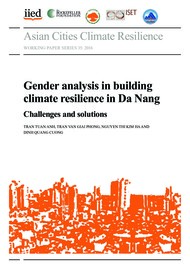Understanding children’s risk and agency in urban areas and their implications for child-centred urban disaster risk reduction in Asia

This paper presents the findings of a study that IIED undertook in partnership with Plan International on urban children’s risk and agency in four large Asian cities: Dhaka (Bangladesh), Kathmandu (Nepal), Manila (the Philippines) and Jakarta (Indonesia). The study involved focus group discussions with street children, working children and squatter and slum children; and key informant interviews with relevant local, national and international agencies involved in child rights and/or disaster risk reduction in each city.
The findings show that girls and boys who live and work on the streets or in low-income informal settlements are among the most vulnerable and susceptible to environmental hazards, disasters and the impacts of climate change, primarily because of their poor-quality living and working and environments. Yet, the majority of disaster risk reduction programmes in urban areas of Asia are dominated by preparedness, early warning and response – and fail to address the particular risks facing boys and girls.
This paper therefore argues for a much greater focus on linking disaster risk reduction with long-term action that can address the provision of protective infrastructure and basic services as key determinants of child-health and disaster and climate resilience. It concludes by outlining a set of priority action areas for Plan International and other child-centred organisations that seek to reduce children’s long-term risks in Asian cities.
Cite this publication
Available at https://www.iied.org/10652iied






